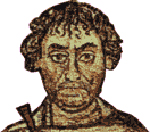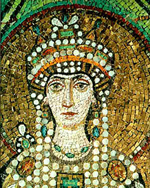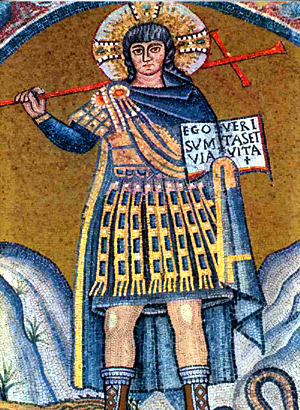 |
The Saint of the Day
Pope St. Silverius, June 20
Prof. Plinio Corrêa de Oliveira
Biographical selection:

St. Silverius suffered
bad treatment from the heretics
|
Theodora, the wife of Emperor Justinian, had named to the see of Constantinople Bishop Anthimus, a partisan of the Monophysite heresy. The Empress then asked that her choice be approved by Rome, but Pope Agapitus deposed Bishop Anthimus and condemned his followers.
St. Agapitus died in 536 and Pope Silverius was chosen as his successor. Theodora attempted again to have her candidate approved by Rome, but she received a negative answer a second time. So she ordered General Belisarius to use force against the Pope to obtain what she desired.
In December 536 General Belisarius went to Rome. Seeing that it was surrounded by the Goths, instead of attacking both the city and the barbarians, he began to spread rumors against the Pope. By means of a forged letter, the Pope was accused of a treasonable agreement and behavior with the Gothic king besieging Rome.

Belisarius
|
St. Silverius did not shake before this pressure, and still refused to carry out Empress’ wishes. Nonetheless, the Pope was forced to leave his palace and find safer shelter in the Church of St. Sabina.
There he was contacted by representatives of the Greek general, who gave him the guarantee he could return to the papal palace without incident. He trusted the word of these representatives, but they were lying. The Pope was kidnapped and exiled to the Island of Ponza in March 537. He died a little more than two years later on June 20, 539 as a consequence of the bad treatment he had received.
Comments of Prof. Plinio:
You can see in this selection the difficult fight of the Pontiffs against the heresies. You also can observe the false, cruel and violent behavior the heretics used against the Roman Pontiff.

The Empress Theodora was a protector of the heresy
|
The heretics of Constantinople used every means they could against St. Silverius. However, they did not achieve their goal because St. Silverius remained faithful. From this episode you can see how great the bad faith of those heretics was.
First, the bad faith of Theodora, the Empress, who was a detestable woman constantly trying to impose heretics as archbishops of Constantinople. She ordered brute force be used to oblige the Pope to approve her candidate.
Second, the bad faith of General Belisarius and his officers. They realized they could not use military force against the Pontiff because the Roman people would defend him. So instead, they spread malicious rumors about him in order to change public opinion. Because of these rumors, the Pope had to move to a different place. Then they sent deceitful ambassadors to the Pope giving him the guarantee that nothing would happen if he would return to the papal palace. He did so, and they kidnapped him.
Something we should always consider is how the sin of heresy is a sin with a supreme malice. Heresy is the worst sin since it is a sin against the Faith. Every man who knows the Catholic Church has the sufficient grace to know that she is the True Church of God. If he refuses to see this, it is because he refuses the truth known as such. The primary of these truths is that the Catholic Church is the only true Church. Therefore, the heretics – like these Monophysite heretics of Byzantium – who had known the Catholic Church and denied her, were in bad faith.
That bad faith generated the other iniquities you heard about in this selection – falseness, cruelty, kidnapping the Pope, and finally his death as a consequence of the bad treatment he received.
What is necessary for a heretic to know the Catholic Church? It is enough, for example, to have seen the example of pious Catholics, participated in various ceremonies as they used to be, heard her chant and considered her elevation, her seriousness, her maternal goodness. If a heretic considers this ensemble, he has conditions to realize that she is a full of wisdom and divine.

Our Lord is represented as a warrior in a mosaic in Ravenna
|
The right thing to do is to show these facets of the Church to the heretic. It should be enough to move not only a Protestant, but also a Schismatic, a Jew, a Muslim etc.
Someone could object to me: This is not the ensemble of the doctrine and teachings of the Church that a person should know to convert. I would reply: You can observe the whole sun reflected in a drop of water, can’t you? The same happens with the Catholic Church. The ensemble of her truth and sanctity can be reflected, and actually is reflected, in the facets I pointed out as examples.
The wrong thing to do is to try to attract the heretic with an ecumenical approach, with little smiles and trying to find common points. No one converts because he finds common points. He changes when he sees the points he is missing.
But if the heretic refuses to accept the Catholic Church, he should be fought and publicly defeated, to prevent his evil from contaminating others. This is not to deny the teachings of Our Lord. Against evil and its followers we should use the whip Our Lord used in the Temple; we should apply the zealous words He spelled out against the hypocritical Pharisees; we should use the sword of fire of St. Michael the Archangel. And we should keep these bad people out of the Catholic Church.
This enmity between the heretics and the Catholic Church is the enmity of which St. Louis Grignon of Montfort speaks. It will exist for all times between the sons of the serpent and the sons of the Virgin. He says that this enmity was created by God when He said: “I will put enmities between thee and the woman, and thy seed and her seed: she shall crush thy head, and thou shalt lie in wait for her heel” (Gen 3:13-15).Therefore, St. Louis Grignon affirms, this enmity was decreed by God Himself, Who only does the most perfect things. It is this mentality of combativeness and vigilance that makes the Church a Militant Church.
These are some considerations suggested by the life of Pope St. Silverius.


  | | Prof. Plinio Corrêa de Oliveira | |
The Saint of the Day features highlights from the lives of saints based on comments made by the late Prof. Plinio Corrêa de Oliveira. Following the example of St. John Bosco who used to make similar talks for the boys of his College, each evening it was Prof. Plinio’s custom to make a short commentary on the lives of the next day’s saint in a meeting for youth in order to encourage them in the practice of virtue and love for the Catholic Church. TIA thought that its readers could profit from these valuable commentaries.
The texts of both the biographical data and the comments come from personal notes taken by Atila S. Guimarães from 1964 to 1995. Given the fact that the source is a personal notebook, it is possible that at times the biographic notes transcribed here will not rigorously follow the original text read by Prof. Plinio. The commentaries have also been adapted and translated for TIA’s site.
|
Saint of the Day | Home | Books | CDs | Search | Contact Us | Donate

© 2002- Tradition in Action, Inc. All Rights Reserved
|
 |

|